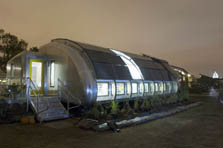

The windows in the Michigan house provide natural light during the day and a lovely view from the outside by night.
(Credit: Chris Gunn, Solar Decathlon)
Solar Decathlon 2005
Today's PV: Functional and Beautiful
Most of us have updated our "look" since the 1970s, and as the teams participating in the 2005 Solar Decathlon discovered, the look of photovoltaic (PV) technologies has been modernized as well. And thanks to a design approach called "building-integrated PV" (BIPV), architects are increasingly finding unique and imaginative ways to incorporate PV panels right into their building designs.
With BIPV, the panels, which come in shades of blue, tan, gray, and green (among others), enhance a structure's visual appeal while producing or supplementing the energy it needs. University of Maryland team member Tom Serra notes: "Because we really believe in this technology, we made a statement—that the panels are beautiful in their own right—by integrating the panels into our home's design."
The PV panels can be configured in a number of ways: as facade systems such as curtain walls, awnings, rain screens, and glazings, or as roofing systems such as skylights and tiles or shingles that form part or all of the roof. When sunlight shines on the panels, direct-current (DC) electricity is created. Power conversion devices then convert that DC power into the alternating-current (AC) power that runs a building's electrical system. As a design strategy, BIPV has a beauty all its own: electricity is produced on site from free sunlight, with no noise, maintenance, pollution, or natural resource depletion.
PV Technology for the Here and Now
More than 30 years of steady technological improvements have brought us these attractive and functional PV systems. Older PV panels were made of crystalline or polycrystalline silicon modules mounted in an aluminum frame between a layer of glass and a rigid supporting material. These modules were delicate and heavy and required numerous manufacturing steps.
In contrast, PV panels are now made of thin-film amorphous silicon. This material has fluid physical properties that make the cells easier and less costly to produce, and it absorbs light more efficiently than its crystalline counterpart. As a result, a thin-film cell can be 100 times thinner than a crystalline cell. In addition, the newer modules are seated on a stainless steel substrate and coated with a weatherproof elastomer polymer ("elastomer" means that the material has rubber-like qualities). These innovations make the thin-film panels unbreakable, much lighter, and less expensive to manufacture and install.
The thin-film panels offer several additional advantages:
- They retain consistent levels of efficiency and electrical production as temperatures rise and fall.
- They produce energy even when partially shaded, and are efficient even in indirect or diffuse light.
- The cost for traditional roofing is eliminated when the panels are used as roofing shingles.
- New quick-connect features and large panels allow for faster and less-expensive installation.
- They are readily available off the shelf.
And because one of the Solar Decathlon's goals is to serve as a proving ground for alternative energy technologies, check out the photos on this Web site or tour the Solar Village during the competition and take special notice of the PV panels. After all, they could be producing clean energy for your home while beautifying your roof!
